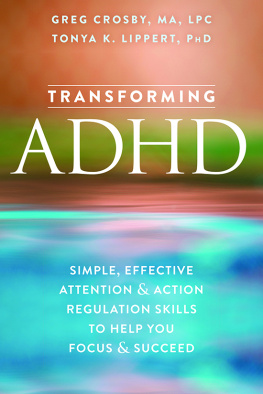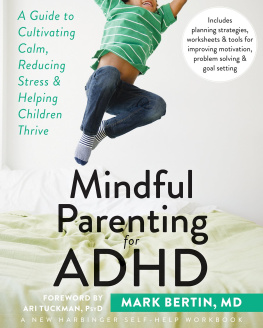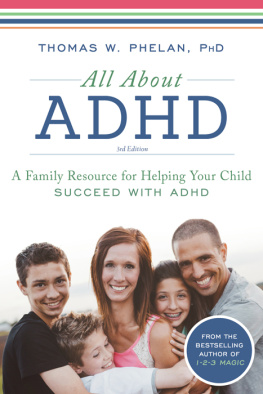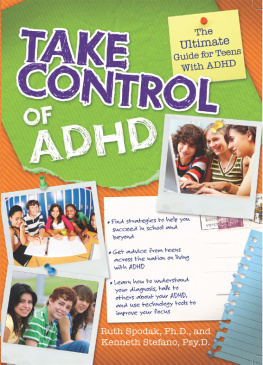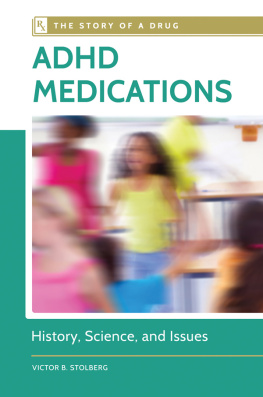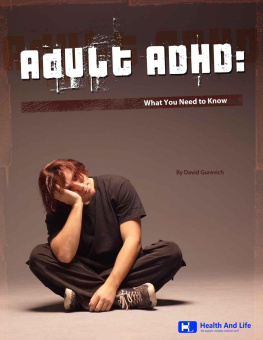
This book is a gem. Crosby and Lippert take this complex andsometimes confusing experienceofliving with attention deficit/hyperactivity disorder (ADHD), and make it imminently understandable. And then they provide a plethora of interesting and doable ideas, as well aspracticalstrategies for youto live the life you want. NOW.
Susan Marie, PMHNP, PhD, associate professor at Oregon Health and Science University, and senior medical director for Behavioral Health in Primary Care, Central City Concern
TransformingADHD strikes that right balance of information that comes both from the head and the heart. Crosby and Lippert provide practical strategies to help adults function better with ADHD that not only are solidly based in the research literature, but also come from a wealth of both clinical and personal experience. ADHD affects adults in so many different ways. The authors understand the impact ADHD has on individuals lives, and the book provides tips that adults can apply in their work and family life along with lots of supportive advice. They really get what its like to live with ADHD.
Bradley Steinfeld, PhD, assistant director at Group Health Cooperative Behavioral Health Services
TransformingADHD is a clearly written and easy-to-use guide for overcoming ADHD and literally rewiring your attention! If this sounds complicated, its notbecause authors Crosby and Lippert weave together engaging, real-life stories, research, brain science, and relationship patterns to re-envision ADHD. Best of all, they offer a set of practical, daily skills and mindful awareness tools for overcoming procrastination and increasing your effectiveness.Whether youre an adult diagnosed with ADHD, or a mental health clinician working in the ADHD field, TransformingADHD is an essential key to unlocking the ADHD puzzle. Amust-have book!
Donald Altman, MA, LPC, author of the best-selling TheMindfulnessToolbox, ClearingEmotionalClutter, and One-Minute Mindfulness
As someone who has had the privilege of having a front row seat to witness Greg Crosby lead workshops for attorneys with ADHD, I anticipated that this book that he partnered with Tonya Lippert to produce would be a solid, research-based resource. It has exceeded my positive expectations. It is written in a clear and efficient style. Their guiding metaphor of flashing lights and guiding lights provided a great focus or lens for the research-based strategies and tools they offer. I appreciated how they were able to relate and reinforce material and tools which they introduced at the start of the book with the material and tools that they followed with. I believe that the population which I work with, attorneys, will find this book to be a helpful and easy-to-digest resource.
Mike Long, attorney counselor, Oregon Attorney Assistance Program
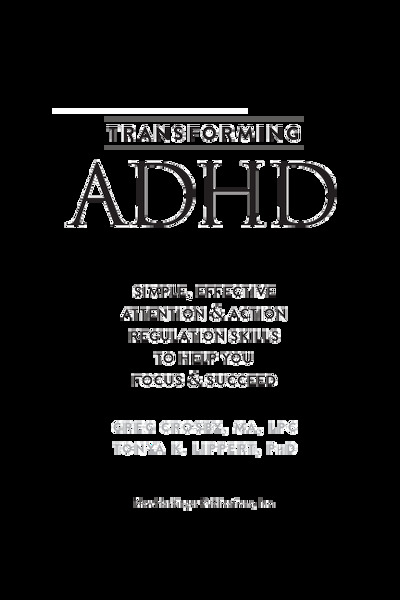
Publishers Note
This publication is designed to provide accurate and authoritative information in regard to the subject matter covered. It is sold with the understanding that the publisher is not engaged in rendering psychological, financial, legal, or other professional services. If expert assistance or counseling is needed, the services of a competent professional should be sought.
The Relationship Structures (ECR-RS) Questionnaire by R. Chris Fraley, copyright 2006 by R. Chris Fraley. Reprinted by permission of the author.
Distributed in Canada by Raincoast Books
Copyright 2016 by Greg Crosby and Tonya K. Lippert
New Harbinger Publications, Inc.
5674 Shattuck Avenue
Oakland, CA 94609
www.newharbinger.com
Cover design by Amy Shoup
Acquired by Melissa Kirk
Edited by Melanie Bell
All Rights Reserved
Library of Congress Cataloging-in-Publication Data on file
We dedicate this book to all whose wandering attention and action led them to us. We hope they will be proud of what weve learned from them.
Everyone knows what attention is. It is the taking possession by the mind, in clear and vivid form, of one out of what seem several simultaneously possible objects or trains of thought. Focalization, concentration, of consciousness are of its essence.
William James, The Principles of Psychology
Contents
L eena earns enough money that she could save up for the things she wants to do, such as travel, but instead she often struggles to pay the bills. Her car is her biggest expense. Traffic and parking tickets eat at her potential savings at a rate of about a thousand dollars a month.
George has some struggles, too. He just started a new job a few months ago and, at first, loved it. Now hes anxious at work. Hes making mistakes that would cost his company big time except that his boss keeps catching them. He often leaves work late both trying to fix mistakes and volunteering to do unpaid things at work, such as hosting events and helping colleagues with their projects.
Leena and George have both been diagnosed with ADHD. The specific ways that their ADHD shows up look different but the underlying patterns of behavior are the same: forgetfulness, careless mistakes, disorganization, distractibility, staying on the go, and restlessness. And they are exhibited to a degree that crosses the line from ordinary to extreme, with heavy consequences.
You may have been diagnosed with ADHD for the same reasons as Leena or George or because you procrastinate doing things that require mental effort over a long time period, have trouble following through, interrupt, talk excessively, or find it hard to wait. And youve probably suffered unwanted consequences, too.
Youve also probably tried some adjustments, knowing what comes easy for you and what comes hard. Perhaps youve found jobs with relatively flexible schedules that require less routine and reward novelty seeking. You may have sought out relationships where your differences work.
But you want more. Its likely youre reading this book to know how to use the latest and greatest understanding of ADHD to transform your life. Youve come to the right place.
Imagine, for a moment, old-fashioned scalesthe kind that tip down on one side and up on the other when the sides are imbalanced. The prevailing story of ADHD has spotlighted one side of the scales: the side of your attention and action that boredom, disinterest, and tedium weigh down. Its counterweight, the side that excitement, interest, and novelty elevate, has remained a side note. In fact, you may hardly hear about this side. But to understand ADHD and the skills you can practice to get what you really want, you need to know it. You need to see both sides of ADHDunderfocus and overfocusand the factors that move each side of the scale.
When you face tasks of little interest to you, particularly future-oriented ones, the defining underfocus and distractibility of ADHD often rear their head. You likely struggle with everyday tasks such as listening; remembering instructions, dates, and appointments; checking the mail; and paying bills. Add impulsiveness and little patience for frustration, and your happiness, relationships, and accomplishments can suffer. As you try to keep up with everyday tasks, you may feel as if you are running all the time without covering much distance. And yet if you ask, Where is my attention? you can find it. You just need to know where to look.
Next page
